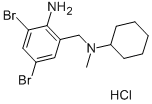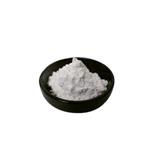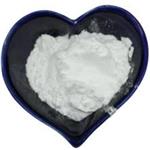Description
Bromhexine Hydrochloride is the hydrochloride salt form of bromhexine, a secretolytic, with mucolytic activity. Upon administration, bromhexine increases lysosomal activity and enhances hydrolysis of acid mucopolysaccharide polymers in the respiratory tract. This increases the production of serous mucus in the respiratory tract, which makes the phlegm thinner and decreases mucus viscosity. This contributes to its secretomotoric effect, and allows the cilia to more easily transport the phlegm out of the lungs. This clears mucus from the respiratory tract and may aid in the treatment of respiratory disorders associated with abnormal viscid mucus, excessive mucus secretion and impaired mucus transport.
Chemical Properties
White Solid
Originator
Bisolvon,Boehringer Ingelheim,Switz.,1963
Uses
Bromhexine hydrochloride was used in the secretion of pancreatic juice of low viscosity.
Uses
Bromhexine hydrochloride is a mucolytic agent used in the treatment of respiratory disorders associated with viscid or excessive mucus.
Bromhexine hydrochloride belongs to the group of expectorants (mucoactive agents). The active substance has a secretolytic effect. It is used for the treatment of strong cough, e.g. triggered by a bronchitis.
Definition
ChEBI: A hydrochloride resulting from the reaction of equimolar amounts of bromhexine and hydrogen chloride. It is used as a mucolytic for the treatment of respiratory disorders associated with productive cough (i.e. a cough characterised by the production of spu
um).
Manufacturing Process
In initial steps, 2-nitrobenzylbromide and cyclohexylmethylamine are reacted
and that initial product reacted with hydrazine to give N-(2-aminobenzyl)-Nmethyl-
cyclohexylamine.
A solution of 29.3 g of bromine in 50 cc of glacial acetic acid was slowly added
dropwise to a solution of 159 g of N-(2-aminobenzyl)-N-methylcyclohexylamine,
accompanied by stirring. The glacial acetic acid was
decanted from the precipitate formed during the addition of the bromine
solution, and the precipitate was thereafter shaken with 200 cc of 2N sodium
hydroxide and 600cc of chloroform until all of the solids went into solution.
The chloroform phase was allowed to separate from the aqueous phase. The
chloroform phase was decanted, evaporated to dryness and the residue was
dissolved in absolute ether. The resulting solution was found to be a solution
of N-(2-amino-3,5-dibromobenzyl)-N-methyl-cyclohexylamine in ethanol. Upon
introducing hydrogen chloride into this solution, the hydrochloride of N-(2-
amino-3,5-dibromobenzyl)-N-methyl-cyclohexylamine precipitated out. It had
a melting point of 232°-235°C (decomposition).
Therapeutic Function
Expectorant; Mucolytic
General Description
Bromhexine hydrochloride is a bronchial mucolytic.




